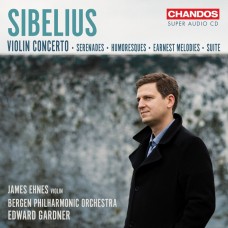西貝流士: 小提琴協奏曲/小夜曲/幽默曲 詹姆士.艾尼斯 小提琴 愛德華.加德納 指揮 卑爾根愛樂管弦樂團 James Ehnes, Edward Gardner / Jean Sibelius: Violin Concerto; Serenades
|
西貝流士: 小提琴協奏曲/小夜曲/幽默曲
西貝流士在年輕時學習小提琴, 並在他學生時期的大部分時間裡積極的考慮未來成為一位職業小提琴家的展望. 在1890年從赫爾辛基音樂學院畢業之後, 他前往維也納繼續深造, 在其間他甚至參加維也納管弦樂團一個職位的面試(但沒有成功). 因此, 該樂器在他的編寫的作品中有著重要的地位是一點也不足為奇了. 但真正令人驚訝的是他只寫過一首協奏曲 – 這也許是因為該作品構想過程的困難度. 第一場演出的評價褒貶不一, 導致他大幅度的修改樂譜. 一直到1930年代海飛茲(Jascha Heifetz)開始定期的表演這首協奏曲才讓這首在標準曲目中獲得應有的地位. 雖然沒有第二號協奏曲, 但西貝流士為小提琴與管弦樂團所寫的作品可不僅僅是小品而已, 正如這張專輯所收錄的充分的證明了這點. 這張是備受國際讚譽的大師詹姆士.艾尼斯與在愛德華.加德納指揮的卑爾根愛樂管弦樂團伴奏下錄製.
Sibelius studied the violin in his youth, and actively entertained the prospect of a career as a professional violinist for much of his student life. After graduating from the Helsinki Music Institute, in 1890, he went to Vienna to continue his studies, and while there he even auditioned (unsuccessfully) for a place in the Vienna Philharmonic Orchestra. So, it comes as no surprise that the instrument plays an important place in his compositional output. What might be surprising is that he wrote only one concerto – this might perhaps be due to the difficult conception of the work. The first performance received mixed reviews, and led to extensive revision of the score. It was only when Jascha Heifetz in the 1930s started to perform the concerto regularly that it gained its place in the standard repertoire. Although there was no second concerto, Sibeliuss numerous other works for violin and orchestra are no mere miniatures, as the recordings on this album amply demonstrate. The acclaimed international virtuoso James Ehnes is accompanied here by the Bergen Philharmonic Orchestra, conducted by Edward Gardner.
|
編號 |
曲目 |
長度 |
作詞 |
作曲 |
演奏 |
樂團 |
演唱 |
指揮 |
試聽 |
|---|



